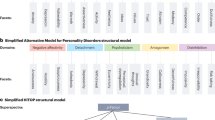Abstract
Introduction
We examined the construct of psychosis using the self-report instrument CAPE (Community Assessment of Psychic Experiences) in a sample of 1,323 students.
Materials and Methods
Taxometric analysis was carried out using Taxometric Programs for the R Computing Environment. The MAXCOV CCFI was 0.34, indicating a dimensional latent structure. All other taxometric analysis yielded very similar results indicative of dimensional structure.
Conclusion
In this study, using powerful analytic techniques designed expressly for the purpose, i.e. taxometric analysis, the latent construct of psychosis in a sample of young students appeared to be consistent with a dimensional, non-taxonic latent structure.




Similar content being viewed by others
References
Brenner K, Schmitz N, Pawliuk N, Fathalli F, Joober R, Ciampi A, King S (2007) Validation of the English and French versions of the community assessment of psychic experiences (CAPE) with a Montreal community sample. Schizophr Res 95:86–95
Daneluzzo E, Di Tommaso S, Tempesta D, Cerroni G, Stratta P, Rossi A (2008) The community assessment psychic experience (CAPE): evaluation study of the Italian version. Epidemiol Psichiatr Soc 17:242–247 [Letters to the Editor (Italian)]
Eaton W, Romanoski A, Anthony JC, Nestadt G (1991) Screening for psychosis in the general population with a self-report interview. J Nerv Ment Dis 179:689–693
Hanssen M, Peeters F, Krabbendam L, Radstake S, Verdoux H, van Os J (2003) How psychotic are individuals with non-psychotic disorders? Soc Psychiatry Psychiatr Epidemiol 38:145–149
Johns LC, van Os J (2001) The continuity of psychotic experiences in the general population. Clin Psychol Rev 21:1125–1141
Krabbendam L, Myin-Germeys I, van Os J (2004) The expanding psychosis phenotype. Int J Psychol Psychol Ther 4:411–420
Lenzenweger MF, Korfine L (1995) Tracking the taxon: on the latent structure and base rate of schizotypy. In: Raine A, Lencz T, Mednick SA (eds) Schizotypal personality Cambridge University Press, Cambridge, pp 135–167
Murphy J, Shevlin M, Adamson G (2007) A latent class analysis of positive psychosis symptoms based on the British Psychiatric Morbidity Survey. Personal Individ Differ 42:1491–1502
Poulton R, Caspi A, Moffitt T, Cannon M, Murray R, Harlins JN (2000) Children’s self-reported psychotic symptoms and adult schizophreniform disorder. Arch Gen Psychiatry 57:1053–1058
Ruscio J, Haslam N, Ruscio AM (2006) Introduction to the taxometric method. A practical guide. Lawrence Erlbaum Associates, London
Schmidt NB, Kotov R, Joiner TE Jr (2004) Taxometrics. Toward a new diagnostic scheme for psychopathology. American Psychological Association, Washington
Shevlin M, Murphy J, Dorahy MJ, Adamson G (2007) The distribution of positive psychosis-like symptoms in the population: a latent class analysis of the National Comorbidity Survey. Schizophr Res 89:101–109
Shevlin M, Adamson G, Vollebergh W, de Graaf R, van Os J (2007) An application of item response mixture modelling to psychosis indicators in two large community samples. Soc Psychiatry Psychiatr Epidemiol 42:771–779
Stefanis NC, Hanssen M, Smirnis NK, Avramopoulos DA, Evdokimidis IK, Stefanis CN, Verdoux H, van Os J (2002) Evidence that three dimensions of psychosis have a distribution in the general population. Psychol Med 32:347–358
Stefanis NC, Delespaul P, Henquet C, Bakoula C, Stefanis CN, Van Os J (2004) Early adolescent cannabis exposure and positive and negative dimensions of psychosis. Addiction 99:1333–1341
Tien A (1991) Distributions of hallucinations in the population. Soc Psychiatry Psychiatr Epidemiol 26:287–292
van Os J, Hanssen M, Bijl RV, Ravelli A (2000) Strauss (1969) revisited: a psychosis continuum in the general population? Schizophr Res 45:11–20
van Os J, Linscott RJ, Myin-Germeys I, Delespaul P, Krabbendam L (2009) A systematic review and meta-analysis of the psychosis continuum: evidence for a psychosis proneness–persistence–impairment model of psychotic disorder. Psychol Med 39:179–195
Verdoux H, Maurice-Tison S, Gay B, van Os J, Salamon R, Bourgeois M (1998) A survey of delusional ideation in primary care patients. Psychol Med 28:127–134
Waller NG, Meehl PE (1998) Multivariate taxometric procedures: distinguishing types from continua. Sage, London
Author information
Authors and Affiliations
Corresponding author
Rights and permissions
About this article
Cite this article
Daneluzzo, E., Stratta, P., Di Tommaso, S. et al. Dimensional, non-taxonic latent structure of psychotic symptoms in a student sample. Soc Psychiat Epidemiol 44, 911–916 (2009). https://doi.org/10.1007/s00127-009-0028-2
Received:
Accepted:
Published:
Issue Date:
DOI: https://doi.org/10.1007/s00127-009-0028-2




